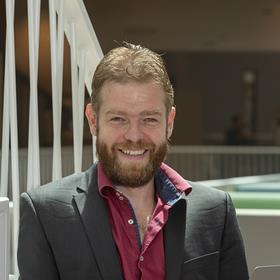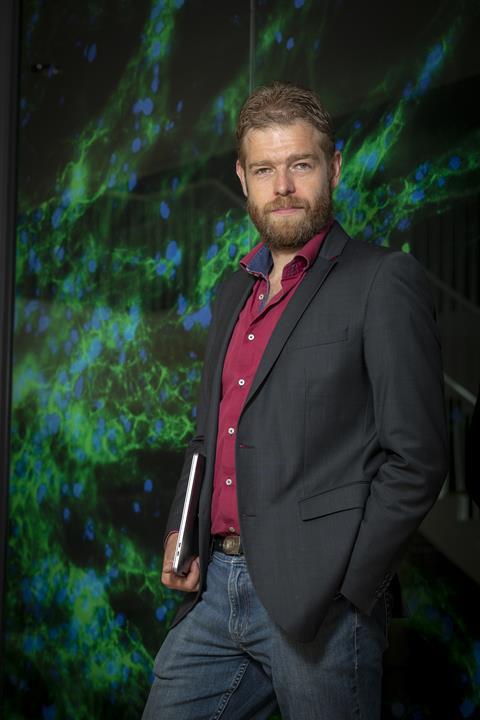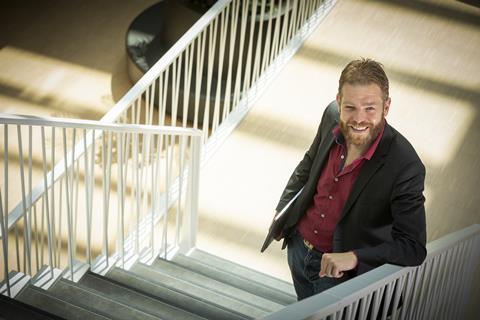Gerard van Westen wants to get his artificial intelligence methods into the lab of as many chemists as possible. He applies these tools in his own work to identify new drug leads faster. For his innovative, multidisciplinary research, he has been awarded the KNCV Gold Medal 2023.
This year, the most important scientific award for chemists under forty, the KNCV Gold Medal, goes to Gerard van Westen, professor of Artificial Intelligence & Medicinal Chemistry at Leiden University. He develops computational methods, here lumped together under the heading of AI (artificial intelligence), which can deepen, broaden and accelerate research into new drugs in many ways. In his inaugurial lecture earlier this year, Van Westen referred to the computer as a “co-pilot” in drug research. ‘We don’t create omniscient algorithms, but tools that allow you to do better research.’

Congratulations on the Gold Medal. I know it’s a cliché, but: were you surprised?
‘Yes, completely surprised. When Yvonne [KNCV president Yvonne van der Meer, ed.] called me a few weeks ago, I thought it was about something completely different. We had just organised the triennial International Conference on Chemical Structures, ICCS, in Noordwijkerhout with the Foundation “Chemische Congressen VI”, which is part of the KNCV. The conference was a succes, but earlier this year, we suddenly were notified by the Dutch Chamber of Commerce that the KNCV wanted to dissolve the foundation because we appeared to be inactive. So I started talking to Yvonne and then the Chamber and it was all straightened out in the end, but when she called me, my first reaction was “it’s not again about that foundation, is it?”. So it took me a while to realise her call was about the Gold Medal.’
And when you realised that?
‘I got a kick, of course. Because I was always very impressed by the people who received this award and what they had done. I never counted myself among that group. I also really like the fact that it is a chemistry prize, because my motivation is precisely to get the things we develop to chemists in the lab. We don’t make omniscient algorithms, but tools that you can use to do better research.’
‘Chemists who don’t use AI will eventually be replaced by chemists who do’
Hence also that metaphor of the co-pilot from your inaugurial lecture?
‘Exactly. I see AI as complementary, it is an inspiration generator. These tools help you to look further, to consult all literature at once instead of only those papers you have time to read yourself. They provide suggestions for new molecules and you decide whether you want to use those suggestions or not. AI is not going to replace the chemist. However, I do think that chemists who don’t use AI will eventually be replaced by chemists who do.’
Do you yourself do anything with the suggestions these tools generate?
‘Yes, we not only develop the tools, we also do experimental research. We work very closely with chemical groups and I also have an organic chemist in my group who synthesizes some of the suggestions from our algorithms in the lab. You get a huge pile of potentially relevant molecules and then you go through that together, what seems interesting, what needs some tinkering, which ones don’t seem promising. And if there are very cool suggestions among them, then we will make them.’
But are these options really surprising? Or could you have come up with them yourself?
‘Both, but the latter is actually good too. When I just started out as a PhD student in medicinal chemistry, I got to present my first work to the group. I showed some molecules and told them that my algorithm could predict that one was active and another was not and then …’
Let me guess: then an senior member of the group raised his hand…
‘Exactly, and he said “I could have told you so”. He was right, of course, but the big difference is that I can go home at the end of the day and say to my algorithm, you keep working. And it does, very consistently. The next morning, I can just grab a cup of coffee and go through the list of suggestions.’
So, the added value of AI tools is primarily in scale and computational power?
‘No, not only but it is the computational power that makes it a game-changer. Look, most algorithms and computational methods don’t do anything complex. It’s not black magic. They perform a simple operation, but they do it very well, very quickly and very consistently. Thanks to that great computational power, these tools can look at all the literature and therefore also come up with unexpected suggestions.’
So you mainly increase the chances of stumbling onto something useful?
‘Yes, exactly that.’
A bigger range can also mean that you mainly get more worthless suggestions.
‘Well, we only use literature data for our algorithms.’
OK, but that doesn’t guarantee high quality.
‘True, but the problem is this: suppose I have synthesised five molecules, or maybe fifty and they all do nothing. They all don’t bind my intented target, even though that was the goal. When I send those data to a journal, no editor will publish it. As a result, our algorithms have a very positive outlook. They are completely convinced of their choices because they see too few negative examples. That is why I am so glad that within Oncode Pact [a National Growth Fund project in which Van Westen is involved, ed.] money has been set aside to design experiments with the explicit aim of finding inactive connections.’
‘AI tools can make chemistry research better’
Because that is needed to make the algorithms work better?
‘Yes, this is really useful for training your algorithms. I have submitted this idea of specifically looking for inactive compounds several times. It was never granted, because “nobody is waiting for this”. But this is precisely what everyone is waiting for. We need to know why substances are not active. That is important for training these methods. I really think this is going to be a very valuable resource.’
It seems like AI has really become a mainstream phenomenon now, especially after all the recent fuss about ChatGPT. But there is also a lot of confusion about what is and is not meant by it.
‘Last year, during my 3 October lecture here in Leiden, I described AI as “sex among teenagers”. Because everyone talks about it, everyone says they do it, because everyone thinks others do it, but actually no one knows exactly what i’s all about. That’s how I see the discussion about AI.’

Nice comparison, but what is it?
‘If you look at what AI means now, it is very often about pattern recognition. People who talk about AI mostly talk about machine learning. But the field is broader, you also have re-inforcement learning, for example, where algorithms assess each other’s ideas, or generative algorithms that create something like image or text. Then there are visualisation techniques and dimensionality reduction techniques. I actually want to apply all these possibilities. For example, we use spam filters to filter out the non-interesting molecules. We use text generators to develop new ideas in the form of SMILES [Simplified Molecular-Input Line-Entry System, with which you convert molecular structure into a sequence of characters, ed.] to develop. We use the latest imaging techniques from the hospital to analyse microscopic images. I want to draw as widely as possible on what is possible. That means working with a lot of different data, which is why we also work closely with LIACS [Leiden Institute of Advanced Computer Science, ed.]. That’s where the real algorithm experts are. They come with their latest algorithm and we contribute our rather messy chemical and biological data and then you can see how well it really works.’
Can you give a concrete example of a problem you are now working on with these techniques?
‘One topic that is becoming increasingly interesting now is multi-objective optimisation. To turn a molecule into a drug, it has to meet many requirements. Of course, it has to be effective, that’s number one. But it must also not cause too many side effects, it must be reasonably soluble, it must have the right physical-chemical properties for formulation, it must be easy to absorb and preferably it must be able to be put into a pill so that it can be taken orally. Those are a lot of, often contradictory, properties and the usual multi-objective optimisation techniques may have three, maybe four requirements and then it stops. But now there is a new field: many objective optimisation!’
That’s a joke.
‘No, that’s really what it’s called and that’s a whole new generation of algorithms being tested precisely on these kinds of difficult problems. We are implementing that now and if you can choose a drug candidate faster and better, that is a major benefit. This is a good example, also because it shows why I like AI so much. After all, you talk to everyone, computer scientists, chemists, biologists, pharmacists. AI brings us together.’
Your specialisation is the development of new drugs. What obstacles in this pathway can we remove or bypass with AI? In other words, for what type of problem does AI really offer a solution?
‘When it comes to small molecules, which is what we focus on, the process starts with searching the chemical space for potential candidates, which go through a whole selection process of lead optimisation, in vitro testing, in vivo testing, etc. We looked at what actions all those steps involve, because an action you can probably turn into an algorithm and then you can save time and ultimately that’s where the main gain in the drug development process is. We focus on the beginning of the process: finding the first hits. You can increase that chance by searching more specifically or by making the space in which you search much bigger. The latter is what we do, we try to search that possible chemical space to see if there are many new possibilities. In doing so, there are still limits, you know the valence of the electrons, you know the approximate size of the molecule, you know which atoms can and cannot be in it. That still leaves an infinitely large, unknown space and we want to explore that, because we don’t know if what we have created in the last two hundred years are really the only possibilities. Is that an island of optimal biological activity or is it only part of the possibilities? We don’t know. So we use algorithms to explore in that unknown space and when we find something, we have to make it and test it. Then you know if you are on the right track.’
And more focused searching or faster selection, are you doing anything about that too? Because there are a lot of gains to be made there too, aren’t there?
‘Yes, we also do that in collaboration with groups within medicinal chemistry or other chemical groups. That might involve finding a molecule that binds slightly better or has fewer side effects. Then it becomes more of an optimisation problem and that is also definitely a main line in our research. Where I really see the future on this is in combining cheminformatics, which is what we are doing now, with pharmacokinetics and dynamics. So including the Pk/Pd in the search and optimisation. Because if you can take that into account at an early stage, with how a substance will behave in the body, then you can make serious gains in selection and start synthesising and testing in a much more focused way.’
The gain, then, is more in faster cleaning of the pipeline by throwing out all hopeless options?
‘You make the irrelevant options disappear faster, that’s the idea. You do want to avoid throwing out the “baby with the bathwater”, as we say in Dutch, which is why we are working on this on other fronts as well. A PhD student in my group combines all those parameters in a virtual drug discovery project and at national level we are working on the Virtual Human for Safety, a project from the National Science Agenda. We are responsible for the chemistry package in that project are working with a researcher who makes mechanistic models and researches Adverse Outcome Pathways. We then link those in turn to Pk/Pd models, so we can say something about the biodistribution. These are very complex problems and we are still at the stage where we all have to learn each other’s language. But that is also great fun, you learn a lot from each other and I hope this will lead to a digital twin, where you can estimate at a very early stage how molecules will behave in a patient. It’s all aimed at increasing the success rate.’
So, does your heart lie with coming up with the algorithms or with answering a molecular question?
‘My work is really centred around developing algorithms, I like figuring out how to model something, but also to see what comes out next and what that means. We are trying to understand chemical and biological phenomena. So, we always work from a chemistry oriented problem, which is the starting point, and then we shop around in computer science to solve it. I don’t need the fanciest algorithm, I prefer something that works and that I can understand and interpret myself. So that I can explain to organic chemists why we are going to make a certain molecule and not just because the computer says so.’
CV Gerard van Westen

2023 - KNCV Gold Medal
2020 - Professor AI and Medicinal Chemistry, Leiden University
2017 - 2020 - Guest lecturer, Xi’an Jiatong University, China
2015 - 2020 Assistant professor, Leiden University
2015 - Founder, Getuyg Data Analytics Consultancy
2013 - Guest lecturer, University of Strathclyde, Glasgow
2012 - 2015 (Senior) postdoc, EMBL-EBI, Hinxton/Cambridge
2012 - PhD, Leiden University













Nog geen opmerkingen